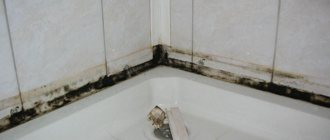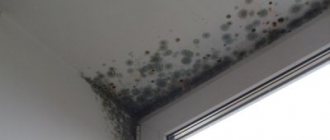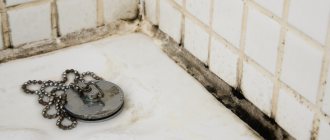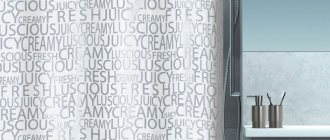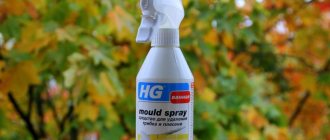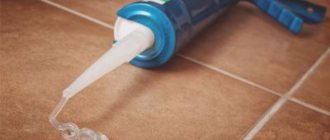Fungus is a frequent visitor to bathrooms. Its favorite habitat is nooks, joints and seams between tiles. Many housewives know that removing mold in the bathroom on sealant is not as easy as removing mold from a smooth bathtub, tiles or shower glass. But effective methods exist, and there are many of them. We invite you to find out how you can get rid of fungus on sealant in a matter of minutes using simple means.
Methods for eliminating mold in the bathroom and shower
The method you choose to combat mold depends on how badly it has affected the caulk and the bathroom as a whole.
- If the fungus is just discovered, soda with vinegar and ammonia will help.
- Tea tree essential oil, borax, UNICUM chemicals and Astonish Mold & Mildew Remover work well against surface mold on sealant.
- To remove black deep mold on sealant, you need strong agents and preparations: cleaning powder and white, a mixture of vinegar, boric acid and hydrogen peroxide, Cillit Bang Anti-Stains, Isotsid, Veksa Bathroom cleaner.
Advice. When using strong products, you need to remove the rug, towels, and shower curtain from the bathroom. If the caustic composition gets on them, stains will remain.
Security measures
When choosing a product, carefully read the instructions and composition. The active substance must be suitable for the specific type of surface. Before use, test the product on a small area - if the composition does not damage the coating, then it can be used for cleaning.
When cleaning mechanically, try not to rub the surface. Acrylic surfaces require special attention: they scratch easily, so it is better not to use rough abrasives or metal sponges.
Don't forget about safety measures:
- be careful when working with a knife and sharp blades;
- carry out cleaning with rubber gloves, and then wash your hands with soap so that strong chemicals do not irritate the skin;
- ventilate the room;
- Use a respirator to protect your respiratory tract.
If a yellow stain remains on the surface after using the chemical, wipe it with soapy water. Then treat with acetone to degrease the product. Repeat if necessary.
Cleaning powder and whiteness
Dish cleaner and whiteness are faithful assistants to the housewife. They can replace expensive household chemicals and cope well with a wide variety of contaminants.
To remove mold on sealant, you need to do the following:
- Sprinkle some cleaning powder onto the area affected by the fungus.
- Rub with a damp sponge or brush.
- Rinse with water.
- Wear rubber gloves and spray the sealant with white to kill fungal spores and remove caustic stains.
- Wait 15 minutes and wash off the whiteness.
In case of severe mold damage, cleaning powder and whitener are used repeatedly (2-3 times every 1-2 days). With each treatment, traces of the fungus become lighter.
How to remove mold
It is important how long ago the fungus appeared. If the area was recently noticed, you can try the following method:
- Fill a container with water and pour in detergent. Mix.
- Soak a sponge in the cleaning solution.
- Remove the fungus.
- Rinse off the detergent.
- Disinfect the surface with the affected area.
- Wait 15-20 minutes.
- Rub the area with a brush or sponge to allow the disinfectant to be absorbed.
- Rinse and wipe the surface dry.
Combination of baking soda and vinegar
Baking soda and vinegar are well-known anti-fungal remedies. They help quickly get rid of mold on the surface and also remove the moldy smell. You can use them separately. But a combination of baking soda and vinegar is more effective. Together they form a foaming agent that easily washes mold out of the grooves, cracks and pits in the sealant. At the same time, the composition is gentle and does not harm the surfaces in the bathroom.
How to clean mold from bathroom caulk with baking soda and vinegar:
- For 2.5 liters of water, take 75 g of baking soda or soda ash (option 2 is better).
- Immediately before use, pour in 50 ml of 9% table vinegar.
- Treat mold-affected surfaces with the solution.
- Leave for 1 hour (can be overnight).
- Rub with a brush and rinse with warm water.
Reviews
Sergey, 26: “I had the same problem. He fought with all available means, including vinegar and copper sulfate. Until I realized that the problem was in the ventilation. Got this thing sorted out. But apparently the problem had already gone deeper during this time, while I was thinking. I had to scrape off all the sealant and re-grout the seams with new ones. Thank God it helped! Although I suffered a lot, since I’m not a builder.”
Yulia, 45: “I did this: first I wiped everything with diluted vinegar, then with bleach. The result lasts for 3 weeks. It’s a pity I didn’t know that the sealant first had to be washed with soap and water. Now I’m afraid that this nasty thing will come out again.”
Vladimir, 37: “In the bathroom, mold appeared exclusively on the sealant, and nowhere else. I do not know why. Since my wife is allergic to everything, I began to solve the problem. I tried all the home methods, but they only helped for a while. And the smell, I must say, still lingered from the whiteness and vinegar. Before that, I disfigured this sealant with this endless washing, whether you like it or not, I had to change it. I bought antifungal and covered it up, and it’s beautiful! I’ve been going into the bath without fear for two months now.”
(
1 ratings, average: 5.00 out of 5)
Borax
Mineral powder is known for its whitening effect, ability to kill cockroaches and fleas, and destroy rust. Borax also has a pronounced antifungal effect.
How to use mold borax on caulk:
- To treat large areas, dissolve a glass of mineral powder in 2.5 liters of water. Pour into a spray bottle. Spray. After 5-10 minutes, brush and rinse the surface with clean water.
- To clean joint sealant, mix borax with a small amount of water to form a paste. Apply to seams and rub with a brush. Rinse the sealant after 10 minutes. For large volumes of mold, you can leave the paste overnight.
Tea tree essential oil
The natural antifungal agent not only removes mold from the sealant, but also has a protective effect. If you do not wash off the solution, but simply ventilate the bathroom, the fungus will bypass the treated areas. Tea tree essential oil does not cause allergic dermatitis and is recommended for use by housewives suffering from allergies to household chemicals.
How to treat mold sealant:
- Dissolve 5 ml of tea tree essential oil in 200 ml of water.
- Apply the solution to tile seams, joints and drainpipes. For convenience, you can use a spray bottle.
- Do not rinse off.
Vinegar, boric acid and hydrogen peroxide
If there is an abundance of black mold on the sealant, prepare a potent mixture of 4 parts water, 2 parts 9% table vinegar, 2 parts hydrogen peroxide and 1 part boric acid. The components are mixed in an old iron bowl or saucepan, and then heated to 40-50 degrees. The solution is applied hot with a sponge. Within half an hour, moldy spots lighten and disappear. At the final stage, the surface is washed with clean water.
Chemicals
Mold is a difficult contaminant to remove. It is not always possible to remove it with home remedies. If the stains are large and the mold has become embedded in the surface, it is necessary to use a more powerful “weapon”.
Chemical preparations not only quickly remove mold stains, but also destroy fungal spores.
They act quickly and efficiently. Seams with sealant often do not even have to be rubbed. It is enough to apply the composition and after a couple of minutes rinse with water from the shower.
Cillit Bang anti-stain
A popular, well-advertised bathroom cleaning product, costing about 250 rubles per 750 ml bottle. Cillit Bang Anti-Stain+Hygiene spray can be conveniently applied to any surface in the bathroom. The clear liquid immediately turns into foam. It has a strong smell of bleach, is very caustic, and requires compliance with safety measures. When removing mold on sealant, you must wear gloves with the doors open and preferably with a protective mask.
The composition is left for 15 minutes and then washed off with water. If necessary, repeat the procedure. Cillit Bang AntiStain+Hygiene effectively removes all fungus, as well as soap and limescale deposits. Surfaces become like new. It copes a little worse with black mold that has become embedded in the sealant - the spots turn brown, lighten, but do not disappear completely.
Unicum
UNICUM bathroom mildew removal cleaner comes in a convenient spray form. Cost - about 180 rubles for a volume of 500 ml. The liquid inside is clear, with a slight smell of bleach and citrus. When sprayed, it forms foam that quickly flows down the wall. Does not cause burns upon short-term contact with skin. Quite gentle.
Removes traces of mold in tile joints in a matter of seconds. The spots lighten before our eyes. After 1 minute, you need to wipe off the product with a cloth and rinse the treated area with clean water. UNICUM cannot cope with advanced mold inside silicone sealant.
ASTONISH Mold & Mildew Remover
Astonish Mold & Mildew Remover is made in the UK. The 750 ml bottle is equipped with a high-quality sprayer, allowing you to use the product sparingly. Costs, on average, 250 rubles. The foam substance has a mild bleach smell and gently cleans delicate surfaces (can even be used on wallpaper).
Astonish Mold & Mildew Remover is applied to mold affected areas for 3-4 minutes. Then you need to lightly rub the area with a brush and rinse off the composition with water. According to reviews, the product is good at removing fungus in the bathroom. After processing the problem does not return. If there is a large amount of mold on the sealant, it is recommended to increase the exposure time to 15 minutes.
Izocid (IZOCID ANTI-MOLD)
The innovative product professionally kills all types of mold, bacteria, fungi, and algae. Izocid (IZOCID ANTI-MOLD) is odorless and non-aggressive on any surface. Also, its feature is its prolonged action. After treatment, the product forms an invisible film that protects against re-formation of fungus for 21 days. If the drug is not washed off, the effect lasts for 5 years!
The drug is a concentrate. It is diluted with water according to the instructions, applied to the affected areas and left for a day. Typically, Izocid (IZOCID ANTI-MOLD) is purchased by enterprises for treating garbage trucks, dry closets, and various buildings and objects. 10 liters of concentrate cost 775 UAH. It is also produced in smaller volumes - 0.5 and 1 liter.
Veksa Bathroom cleaner
Veksa Bathroom cleaner from Pro-Brite is a professional product against fungus in the bathroom. Available in the form of a concentrate of 10 liters and in bottles with a 500 ml dispenser, costing about 160 rubles. It is used in industries and has powerful bleaching and disinfecting properties. Contains chlorine and has a pungent odor. Processing must be carried out in personal protective equipment.
To remove mold on the sealant, the drug is applied to the dirt and rubbed with a brush. Exposure time – 10-25 minutes. Then the composition is washed off. If necessary, repeat the treatment.
Reasons for appearance
Mold is a lower organism that reproduces by spores. They are present in the air in small quantities, but under certain conditions they begin to actively spread. This is why it is important to know why mold appears in the bathroom and how to get rid of it. The settled particles begin to grow under the following conditions:
- air temperature > +20ºС;
- humidity > 90-95%;
- insufficient level of ventilation in the room;
- constant local accumulation of moisture;
- poor hygiene.
When the humidity in the bathroom is high, condensation forms on the wall. It flows down in the form of drops. Areas of increased moisture accumulation in the bathroom occur in the lower part of the wall, where mold often appears on the seams of the sealant.
Note! For the surface to dry, the water must evaporate. This process takes several hours. There is constant long-term exposure to moisture, which causes mold growth, since fungus does not grow in dry air.
Mold forms on any surface: wood, plastic, metal, silicone, ceramic tiles. If the material is dense and the fungus cannot penetrate inside, it settles and grows on the surface. Mold can be white, brown, or red. Black is found on the sealant.
If the problem returns...
Recurrence of mold on bathroom caulk is not uncommon. Mold will form again and again until prevention is carried out. You should go through the steps again and make sure that they are all completed.
Possible mistakes:
- There is a source of mold in the bathroom. It may be in a hard-to-reach place: on the back of a cabinet, under the sink, or somewhere else. Fungal spores easily travel through the air and infect new places.
- The hood cannot handle the amount of moisture in the room. Even the most powerful exhaust fan will be powerless if wet rags are stored in the bathroom and damp terry towels hang.
- The cleaning product is too gentle and does not completely destroy the fungus.
Questions and answers
What bathroom sealant won't mold?
Experts recommend choosing silicone sealants with antifungal additives from well-known companies: Dow Corning, Kiilto, Moment, Titan, Ceresit. Sanitary compounds resist mold well, and their application does not require special skills. Polymer sealants that are more resistant to fungus require high professionalism, accuracy, speed and accuracy from the worker. Therefore, MS polymers are not recommended for independent use at home.
How to properly deal with mold on sealant in a shower stall?
To clean the sealant in the shower stall, the same products are used, with a small caveat. The cabin must be open during processing, and the respiratory tract must be protected with a respirator (if chlorine products are used).
You can fight mold on sealant using folk and chemical means. The fungus is well removed by soda, vinegar, all kinds of cleaning powders and cleaners with sodium hypochlorite. But they help only at the initial stage, when the moldy spots are outside. The mycelium of facultative parasites is able to grow into the thickness of silicone sealant. If cleaning is not carried out in a timely manner, and the mold has “eaten through” the silicone, there will be nothing left but to replace the sealant and carefully treat the space underneath it.
What is the danger of black fungus?
Children, the elderly and people with reduced immunity suffer the most from the fungus. The danger is associated with negative health effects.
Problems caused by the development of fungus in the bathroom:
asthma;- pneumonia and other respiratory disorders;
- nausea;
- loss of appetite;
- exacerbation of allergic manifestations;
- dermatological and other pathologies.
From the sealant used for waterproofing, pathogenic flora can get onto bath accessories and accumulate in the air. In addition to affecting the health of households, mold has a detrimental effect on engineering structures, destroying materials.
Knowing about all these features, fungus on the sealant should be dealt with carefully, and preferably in the initial stages. Fungal colonies should not be allowed to grow .
